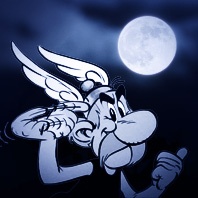Rubrik: Worth seeing
Have you ever wondered, after you took a photograph of the full moon that the Moon looks much smaller on the picture than as it appears to you in real? This effect occurs particularly when the Moon is above the horizon. This is a so-called Moon illusion, which is an optical illusion, meaning it can only be seen this way through our perception and is therefore not depicted on the photograph.
Read more
The Moon circles the Earth. But indeed, it is no circle, but an ellipse, which portrays itself in space like a kind of spiral, because the Earth, together with the Moon, circles the Sun. And thus, the distance between the Earth and the Moon does not remain the same, but continuously changes. The distance varies between approx. 357,000 km/222,000 mi (called perigee) to approx. 406,000 km/252,000 mi (called apogee).
Read more
Even though the title of this article may suggest it, the following is not about James Bond, the famous secret agent of Her Majesty, but about another legend, which supposedly happened in Wiltshire in southern England.
A gang of alcohol smugglers tried to hide barrels in a pond of a village from the eyes of the official custom officers. When they were caught by them one night at the shore and were asked to explain themselves, the smugglers tried to rake the surface of the water in order to make the view onto the barrels more difficult. They then claimed that they were trying to fish a round cheese out of the pond and pointed at the reflection of the full moon in the water. The officers thought them to be insane and simply granted them to continue as pleased.
Read more
You always hear that certain things should be done or left undone at certain phases of the lunar cycle, also during a full moon. You can believe it or not. It surely cannot be proven and to be honest, we are quite skeptical with regards to the attribution of human activities and lunar events. However, we would not like to exclude it – after all neither the efficacy nor the inefficacy of such theses has been proven. As long as you don’t get caught in your own convictions, it is part of people’s liberty to create their lives freely.
Read more
Does the full moon light have an influence on how fish bite when fishing? Some claim it is pointless to fish during a full moon, but others are adamant that their catches are particularly good during a full moon and can barely be surpassed.
It can be assumed that it is more the moonlight, which could bear an effect, rather than the astronomical event full moon itself (which can also take place during the day, as we have already outlined). Hence, it should hardly make a difference whether one goes fishing in the night before/after or during a full moon itself, because the amount of light is roughly the same and is more influenced by clouds and weather rather than by the exact constellation of planets.
Read more
One obviously has the night sky before one’s eyes when thinking of the full moon. In reality, however, the event »full moon« has nothing to do with the fact whether it is night or day for us. The full moon occurs when Sun – Earth – Moon form a line in space and exactly in this order. The Earth lies in fact between the Sun and the Moon. Depending on what time this happens, it is night on the hemisphere that is turned away from the Sun and you can see the Moon in the sky. But on the hemisphere that is turned towards the sun it is daytime at this point and the full moon cannot be seen, because when observed from this position it is actually behind the Earth.
Read more
Shortly before Easter, we are taking a look at Christianity and notice that a very important event must have taken place at the full moon: the Last Supper of Jesus and his disciples. From a historical point of view, the Last Supper derives from the Jewish Passover feast (Seder), which traditionally takes place on the eve of Passover. This meal is being celebrated on the 14th Nisan, which is always the first full moon after the spring equinox – the beginning of spring. This is how later, the calculation of the Easter date had been determined: »Easter takes place on the Sunday after the first full moon in spring.«
Read more
Who doesn’t know them, the fearless Gauls Asterix and Obelix, who have been making the hearts of comic fans leap for joy since decades and who impress again and again through witty texts and masterful drawings. The stories originate from the pen of the French illustrator Albert Uderzo (1927–2020), who created, together with his fellow countryman René Goscinny (1926–1977), the first comic in the year 1959, and with that, brought the adventures of the brave Gaul to life.
Read more
When observing the Moon, you can see dark spots on its surface. In the old days, these were thought to be the seas and oceans just like on Earth, so they were called »mare« (plural: »maria«). Giovanni Riccioli (1598–1671), an Italian priest and astronomer was leading in this area and was responsible for giving many lunar maria their Latin or partially poetic names. We would like to single out a few that we consider to be worthwhile mentioning.
Read more
Sleepwalking is the term for a sleep disorder where the person concerned will move to an upright position in bed, or get up and walk around without waking up. It is also referred to as somnambulism, which derives from lat. »somnus« = sleep and »ambulare« = to wander. A further outdated term is »lunatism« and stems from the former belief that the light of the full moon coaxes the sleeper into leaving the bed. This misconception is scientifically disproved: sleepwalking takes place outside the lunar cycle.
Read more










